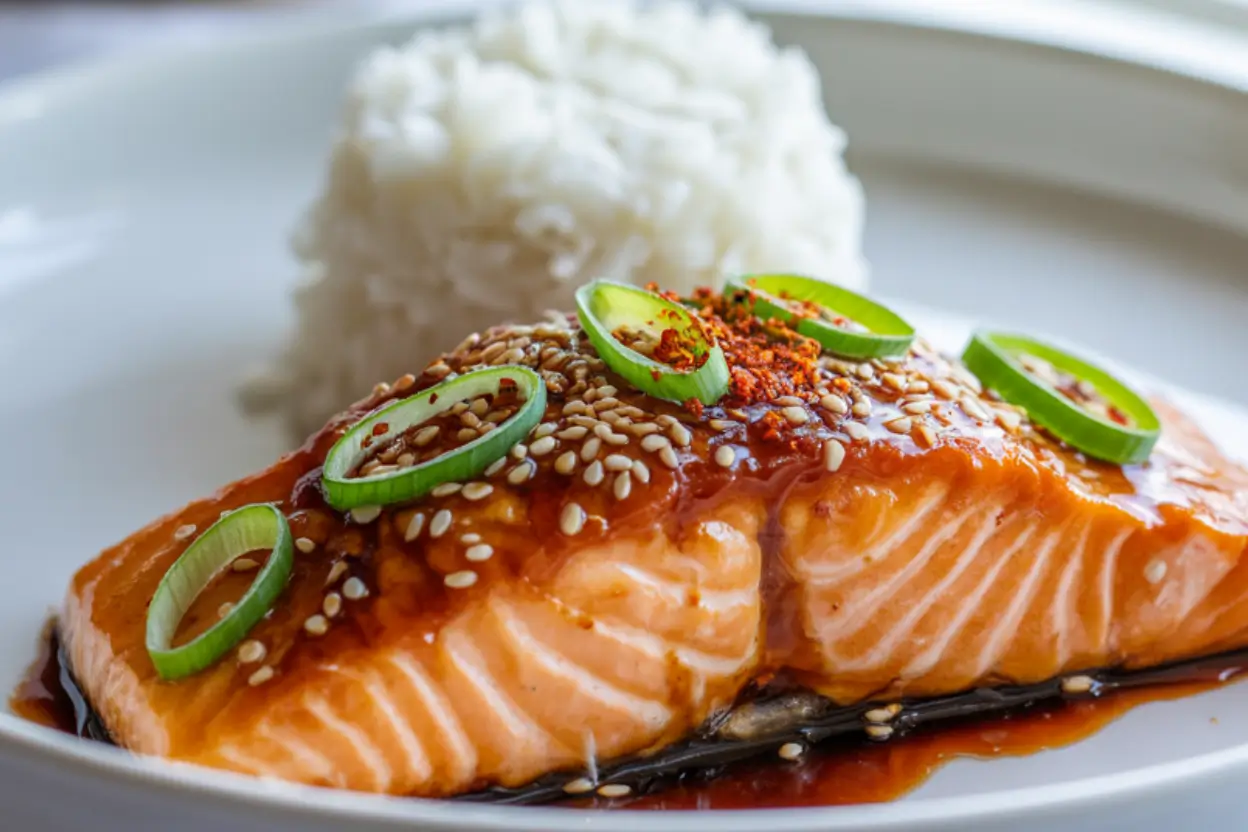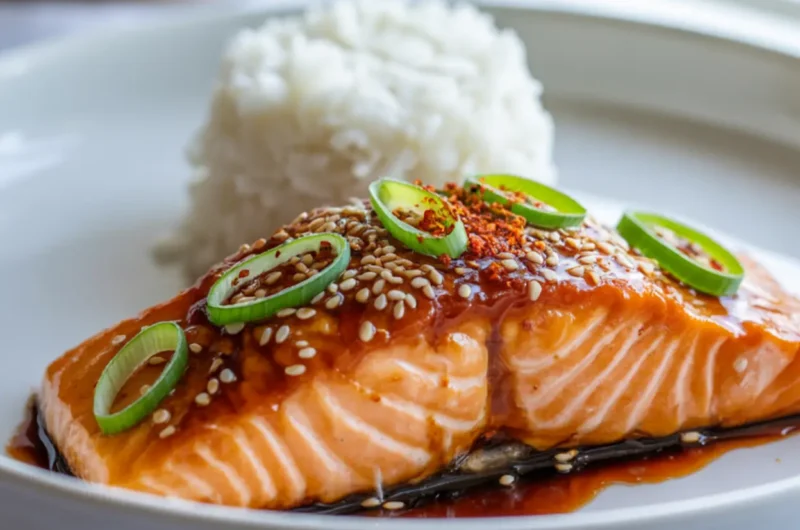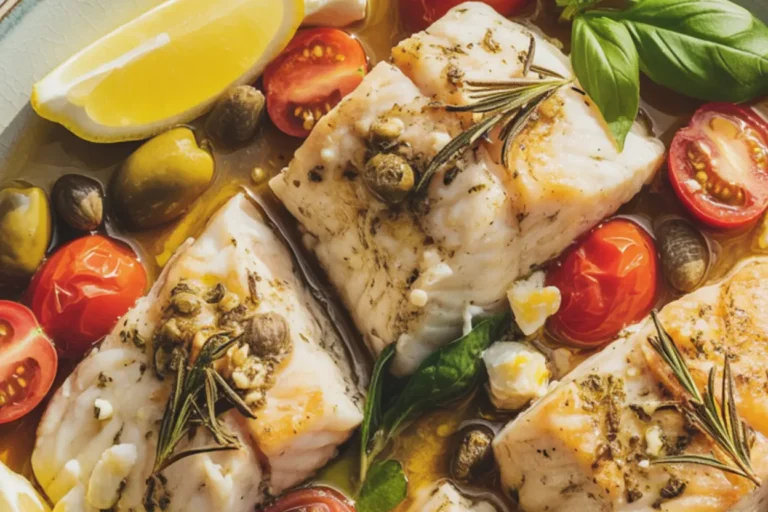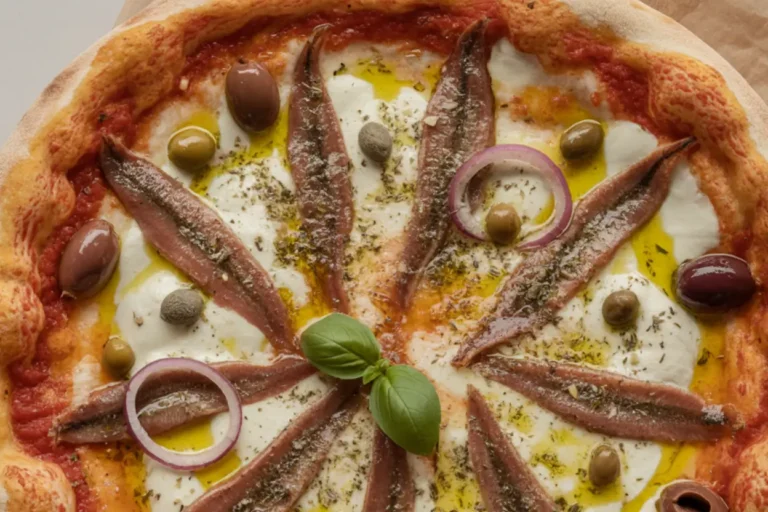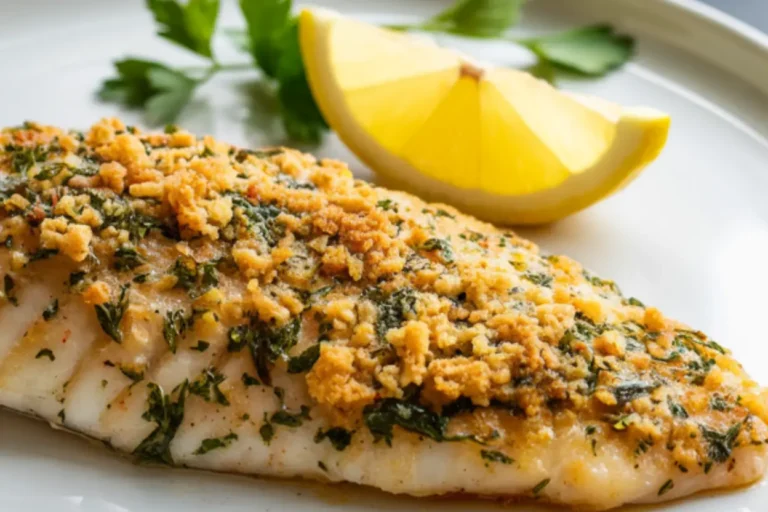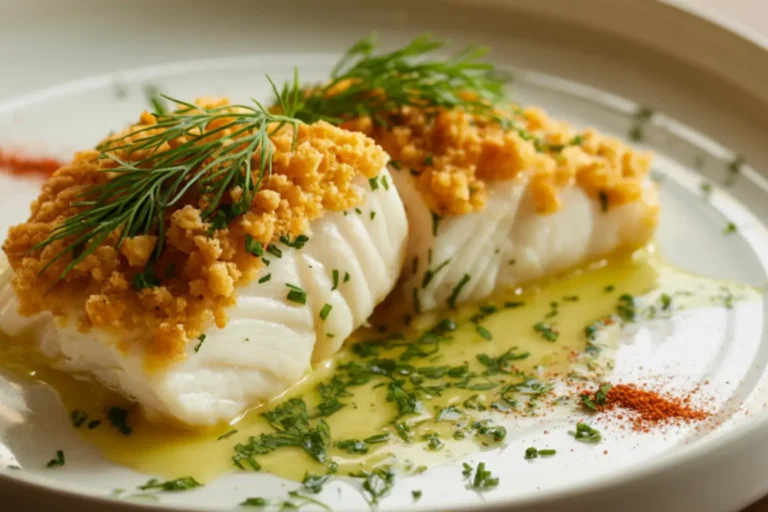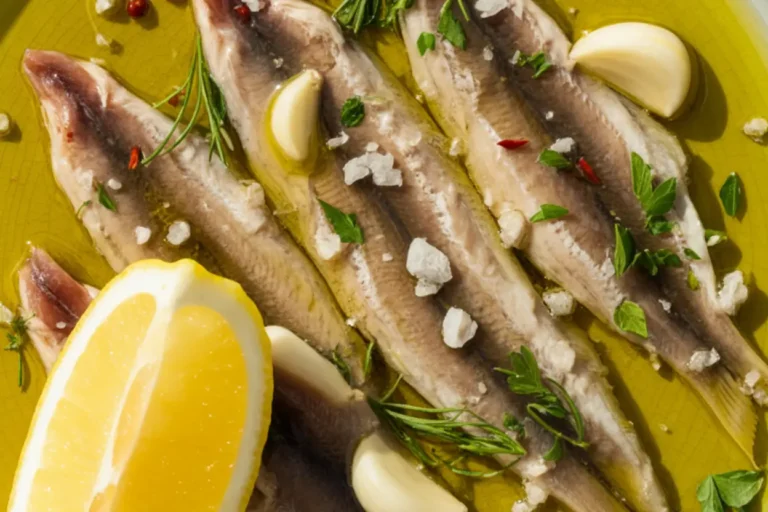Baked Teriyaki Salmon: 7 Tips to Nail the Perfect Glaze
Table of Contents
There’s something magical about the combination of tender, flaky salmon and a rich, glossy teriyaki glaze. When done right, baked teriyaki salmon strikes that perfect balance between sweet and savory, with an irresistible umami flavor that makes it a standout dinner option. After years of perfecting this dish in my own kitchen, I’m excited to share my foolproof method for creating restaurant-quality baked teriyaki salmon right in your home oven. Whether you’re cooking for a special occasion or just want to elevate your weeknight dinner routine, this recipe delivers impressive results with minimal effort.
Thank you for reading this post, don't forget to subscribe!How to Make Baked Teriyaki Salmon
Quick Overview
Baked teriyaki salmon combines the health benefits of omega-rich salmon with the complex sweet-savory flavors of homemade teriyaki glaze. What makes this version special is the perfect balance in the sauce – not too sweet, not too salty – and a foolproof baking technique that ensures moist, tender fish with a perfectly caramelized exterior. The homemade teriyaki glaze features the classic combination of soy sauce, ginger, and garlic, but with a few special additions that create depth without overwhelming the delicate salmon flavor. The entire dish comes together in just 35 minutes (15 minutes prep, 20 minutes cooking), making it accessible even on busy weeknights. The presentation is stunning, with the glossy, mahogany-colored glaze creating a professional-looking finish that belies how simple this dish is to prepare.
The Ingredients I Use to Bring My Baked Teriyaki Salmon to Life
For the Salmon:
- 4 salmon fillets (about 6 oz each), skin-on, preferably center-cut
- ½ teaspoon sea salt
- ¼ teaspoon freshly ground black pepper
- 1 tablespoon neutral oil (such as avocado or vegetable oil)
For the Teriyaki Glaze:
- ½ cup low-sodium soy sauce
- 3 tablespoons honey
- 2 tablespoons brown sugar, packed
- 2 tablespoons rice vinegar
- 1 tablespoon sesame oil
- 3 cloves garlic, minced (about 1 tablespoon)
- 1 tablespoon fresh ginger, grated
- 1 tablespoon cornstarch
- 2 tablespoons cold water
For the Garnish:
- 1 tablespoon of sesame seeds—using a mix of white and black adds a nice visual touch.
- 2 green onions, thinly sliced on the diagonal
- ½ teaspoon red pepper flakes (optional, if you enjoy a bit of heat)
Step-by-Step Instructions
1. Prepare the Salmon
- Preheat your oven to a perfect 400°F (200°C). This temperature is crucial – hot enough to cook the salmon quickly while allowing the glaze to caramelize without burning.
- Line a rimmed baking sheet with foil or parchment paper to make cleanup quick and easy. If using foil, give it a light coating of cooking spray to prevent sticking.
- Pat the salmon fillets dry with paper towels. This step is essential for ensuring the seasoning adheres properly and helps achieve a better sear when the salmon hits the hot pan.
- Season the flesh side of the salmon with salt and pepper. Be careful not to oversalt, as the teriyaki glaze will add significant saltiness to the final dish.
- Let the seasoned salmon rest at room temperature for about 15 minutes while you prepare the glaze. This takes the chill off the fish and promotes even cooking.
2. Make the Teriyaki Glaze
- In a medium saucepan, combine soy sauce, honey, brown sugar, rice vinegar, sesame oil, minced garlic, and grated ginger.
- Place the saucepan over medium heat and bring to a gentle simmer, stirring occasionally to help the sugar dissolve completely.
- In a small bowl, create a slurry by whisking together the cornstarch and cold water until smooth. This will help thicken the glaze to the perfect consistency.
- When the sauce begins to simmer, slowly whisk in the cornstarch slurry, making sure to stir constantly to keep it smooth and lump-free.
- Continue to simmer the glaze, stirring frequently, for about 3-4 minutes until it thickens enough to coat the back of a spoon. You’re looking for a consistency similar to maple syrup – not too thick, as it will continue to thicken as it cools.
- Remove the glaze from heat and allow it to cool slightly for about 5 minutes. As it cools, it will develop a more syrupy consistency that will adhere beautifully to the salmon.
3. Prepare and Bake the Salmon
- Heat a large oven-safe skillet (preferably cast iron) over medium-high heat. Add the tablespoon of neutral oil and allow it to get hot but not smoking.
- Place the salmon fillets in the hot skillet, skin side down. The skin acts as a protective barrier between the heat and the delicate flesh. Sear for approximately 3 minutes until the skin begins to crisp.
- Remove the skillet from heat and carefully spoon about ⅓ of the teriyaki glaze over the salmon fillets, ensuring each piece is evenly coated. Reserve the remaining glaze for basting and serving.
- Transfer the skillet to the preheated oven and bake for 8-10 minutes. The exact time will depend on the thickness of your fillets and your preferred doneness. For medium, look for an internal temperature of 125-130°F (52-54°C) at the thickest part.
- At the halfway point (about 4-5 minutes), open the oven and carefully baste the salmon with another ⅓ of the glaze. This creates layers of flavor and helps develop that beautiful lacquered finish.
4. Finish and Serve
- Once the salmon reaches your desired doneness, remove it from the oven and immediately brush with the remaining glaze while still hot. The residual heat will help set the final layer of glaze into a beautiful, shiny finish.
- Sprinkle the glazed salmon with sesame seeds and allow it to rest for 2-3 minutes. This resting period allows the juices to redistribute throughout the fish, ensuring maximum tenderness and flavor.
- Garnish with sliced green onions and optional red pepper flakes just before serving for a pop of color and freshness that balances the rich glaze.
What to Serve Baked Teriyaki Salmon With
Baked teriyaki salmon pairs beautifully with a variety of sides that complement its sweet-savory profile. Here are some excellent options:
Rice and Grain Options:
- Fluffy Jasmine Rice: The subtle floral notes and light texture make it perfect for soaking up extra teriyaki sauce.
- Coconut Rice: Adds a tropical element that pairs wonderfully with the Asian flavors.
- Brown Rice: For a more nutritious option that adds a pleasant nuttiness.
- Quinoa: A protein-packed alternative that absorbs the flavors of the teriyaki beautifully.
Vegetable Sides:
- Steamed Broccoli: The slight bitterness provides a perfect counterpoint to the sweet glaze.
- Roasted Bok Choy: Becomes slightly charred and sweet when roasted, complementing the salmon.
- Cucumber Salad: Tossed with rice vinegar and sesame seeds for a cooling contrast.
- Stir-Fried Snow Peas and Red Bell Peppers: Adds color, crunch, and freshness.
Salad Options:
- Asian Slaw: Made with cabbage, carrots, and a rice vinegar dressing.
- Seaweed Salad: For an authentic Japanese pairing with mineral notes that enhance the salmon.
- Avocado Salad: The creamy texture works wonderfully with the glazed salmon.
Beverage Pairings:
- Green Tea: Its slight astringency cuts through the sweetness of the glaze.
- Lemongrass Iced Tea: Refreshing with subtle citrus notes.
- Pinot Noir: If serving wine, a light-bodied red with low tannins works surprisingly well.
- Dry Riesling: A white wine option with enough acidity to balance the dish.

Top Tips for Perfecting Baked Teriyaki Salmon
After years of making this dish, I’ve discovered several key techniques that elevate baked teriyaki salmon from good to unforgettable:
1. Choose the Right Salmon
- Look for center-cut salmon fillets of even thickness (about 1-1.5 inches) to ensure even cooking.
- Wild-caught salmon generally has a more robust flavor that stands up well to the teriyaki glaze, but high-quality farmed salmon works too.
- If possible, buy salmon with the skin on, as it helps keep the fish moist during cooking and provides a barrier between the heat and the delicate flesh.
2. Perfect Your Glaze Consistency
- The cornstarch slurry is crucial for achieving that restaurant-quality thickness. Too little and the glaze will be watery; too much and it becomes gloppy.
- Always mix cornstarch with cold water before adding to the hot sauce to prevent clumping.
- The glaze should coat the back of a spoon but still flow slowly when poured – think maple syrup consistency.
3. Layer Your Glaze
- Applying the glaze in multiple layers (before baking, halfway through, and after) creates depth of flavor and that beautiful lacquered finish.
- Reserve some glaze for serving to add a final fresh hit of flavor at the table.
4. Monitor Temperature Carefully
- Salmon is at its best when cooked to medium (125-130°F or 52-54°C internal temperature). It will be slightly translucent in the center but still flaky.
- Invest in an instant-read thermometer for precision – it’s the difference between perfectly moist salmon and dry, overcooked fish.
5. Use the Sear-then-Bake Method
- Starting the salmon in a hot skillet before transferring to the oven gives you the best of both worlds: crispy skin and tender flesh.
- If you don’t have an oven-safe skillet, you can sear in a regular pan and then carefully transfer to a preheated baking sheet.
6. Rest Before Serving
- Allow the salmon to rest for 2-3 minutes after removing from the oven. This lets the juices redistribute and the glaze set properly.
- During this rest period, the salmon will continue cooking slightly from residual heat, so remove it from the oven just before it reaches your desired final temperature.
7. Substitution Guide
- No honey? Use maple syrup for a different but equally delicious flavor profile.
- For a gluten-free version, substitute tamari for the soy sauce.
- Fresh ginger is strongly preferred, but in a pinch, you can use 1 teaspoon of ground ginger instead.
- If you’re watching sugar intake, reduce the brown sugar and increase the natural sweetness with an additional tablespoon of honey.
Storing and Reheating Tips
Properly stored and reheated, baked teriyaki salmon can be almost as delicious the second time around:
Refrigeration:
- Allow leftover salmon to cool completely before refrigerating, but don’t leave it at room temperature for more than 1 hour.
- Keep it in an airtight container in the fridge, and it’ll stay fresh for up to 2 days. The teriyaki flavor actually continues to develop overnight, sometimes making day-two salmon even more flavorful.
- If you have extra unused glaze, store it separately in the refrigerator for up to 1 week. It makes an excellent sauce for other proteins or stir-fries.
Freezing Guidelines:
- While fresh is best, you can freeze cooked teriyaki salmon if necessary. Wrap individual portions tightly in plastic wrap, then aluminum foil, and place in a freezer-safe bag.
- Frozen cooked salmon will maintain good quality for about 1 month. Beyond that, the texture may deteriorate.
- Thaw overnight in the refrigerator before reheating for the best texture.
Reheating Methods:
- Gentle Oven Reheat (Best Method)
- Preheat your oven to 275°F (135°C)
- Place the salmon on a parchment-lined baking sheet
- Cover loosely with foil to prevent drying out
- Heat for 15 minutes or until just warmed through
- For extra moisture, add a tablespoon of water under the foil to create steam
- Stovetop Steaming
- Create a simple steamer by adding an inch of water to a skillet
- Place a heat-proof plate on an inverted bowl in the skillet
- Arrange the salmon on the plate, cover the skillet
- Steam on low heat for 5-7 minutes until just warmed through
- Microwave Method (Quick but Not Ideal)
- If you must use a microwave, place the salmon on a microwave-safe plate
- Cover with a damp paper towel to help keep it moist.
- Heat at 50% power in 30-second intervals until just warm
- Be extremely careful not to overheat, as salmon dries out quickly in the microwave
Creative Leftover Ideas:
- Flake cold leftover teriyaki salmon over a salad for a delicious lunch
- Mix into hot rice with avocado and cucumber for an easy poke-inspired bowl
- Use as filling for onigiri (Japanese rice balls)
- Incorporate into scrambled eggs with green onions for a protein-packed breakfast
With these detailed instructions and tips, you’ll be able to create a stunning baked teriyaki salmon that rivals any restaurant version. The combination of the perfectly cooked fish and the rich, glossy glaze makes for an impressive meal that works equally well for weeknight dinners or special occasions. Once you master this technique, you’ll find yourself returning to it again and again – it’s that good!
Baked Teriyaki Salmon: 7 Tips to Nail the Perfect Glaze
Cuisine: Japanese-InspiredDifficulty: Easy4
servings15
minutes15
minutes400–450
kcalTender, flaky salmon fillets glazed with a sweet, savory, and slightly spicy homemade teriyaki sauce. This baked version is simple, flavorful, and comes together quickly with a glossy finish and delicious umami depth. A perfect dinner option that feels both wholesome and indulgent.
Ingredients
4 salmon fillets (about 6 oz each), skin-on, preferably center-cut
½ teaspoon sea salt
¼ teaspoon freshly ground black pepper
1 tablespoon neutral oil (such as avocado or vegetable oil)
½ cup low-sodium soy sauce
3 tablespoons honey
2 tablespoons brown sugar, packed
2 tablespoons rice vinegar
1 tablespoon sesame oil
3 cloves garlic, minced (about 1 tablespoon)
1 tablespoon fresh ginger, grated
1 tablespoon cornstarch
2 tablespoons cold water
1 tablespoon of sesame seeds—using a mix of white and black adds a nice visual touch.
2 green onions, thinly sliced on the diagonal
½ teaspoon red pepper flakes (optional, if you enjoy a bit of heat)
Directions
- Prep the Salmon
Preheat your oven to 400°F (200°C) and line a baking sheet with foil or parchment paper. Pat the salmon fillets dry and season lightly with salt and pepper on the flesh side. Let them rest at room temperature for about 15 minutes while you prepare the teriyaki glaze. - Make the Teriyaki Glaze
In a saucepan over medium heat, combine soy sauce, honey, brown sugar, rice vinegar, sesame oil, garlic, and ginger. Simmer gently, then whisk in a cornstarch and water slurry. Continue cooking for 3–4 minutes until the glaze thickens to a syrup-like consistency. Let it cool slightly to develop a smooth, glossy texture. - Sear and Bake the Salmon
Heat oil in an oven-safe skillet over medium-high heat. Sear the salmon skin-side down for about 3 minutes until the skin crisps. Spoon a third of the glaze over the fillets, then transfer the skillet to the oven. Bake for 8–10 minutes, basting once halfway through with another third of the glaze for rich, layered flavor. - Finish and Serve
Brush the salmon with the remaining glaze immediately after baking. Let it rest for 2–3 minutes, then garnish with sesame seeds, sliced green onions, and optional red pepper flakes. Serve hot for the best flavor and texture.
Notes
- This recipe is a great balance of flavor and nutrition. The homemade teriyaki sauce is made from pantry staples like soy sauce, honey, brown sugar, sesame oil, garlic, and ginger, giving it a rich, sticky texture without needing bottled sauces. Baking the salmon keeps it moist and hassle-free. The optional red pepper flakes add a nice kick, while sesame seeds and green onions brighten the final presentation. Serve it over rice, noodles, or steamed veggies for a complete, satisfying meal.

